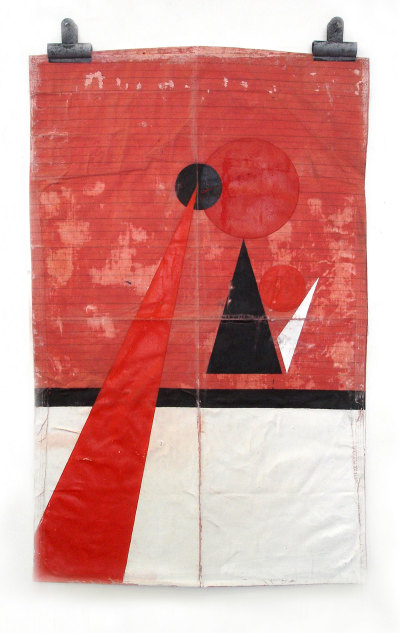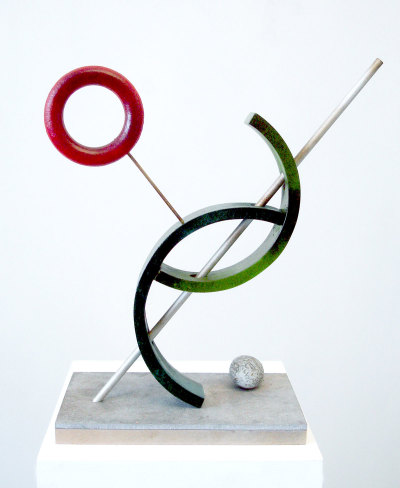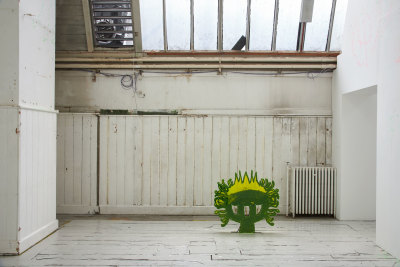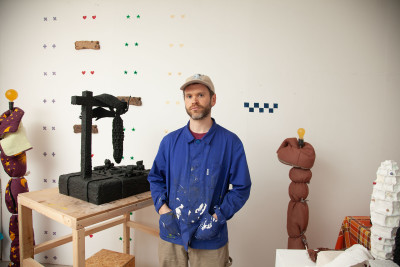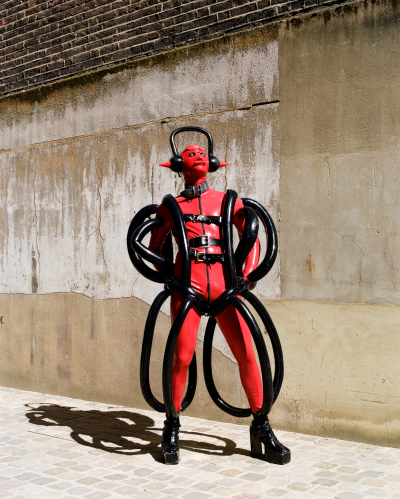Catching up with… Tim Ellis
Catching up with… Tim Ellis
Graduates of the RA Schools
By Carys Frankland
Published 21 September 2015
Six years on from leaving the RA Schools and selling his final year show to the Saatchi Gallery, Tim Ellis has been exhibiting across the world. We head to his Dalston studio.
-
Drawing inspiration from what he sees around him, Ellis has developed a unique visual language. Referencing everything from chemical symbols to Japanese screens, he leaves viewers questioning the work’s cultural origin and the mark of an individual author’s hand. His paintings are heraldic, raised like flags or strung across a gallery wall like an ancient festival banner; his sculptures are totemic, proclaiming a community spirit and bearing the ravages of time.
Born in Chester, Ellis graduated from the RA Schools in 2009. His career swiftly launched when his final year show was bought by the Saatchi Gallery, Ellis has been exhibiting across the UK and internationally ever since. Alongside a host of solo and group shows, he has curated exhibitions as far afield as Hong Kong, and has for the last two years been co-running an exhibition space called Horatio Junior in south London.
On a visit to his studio, Ellis shared some insight into his practice.
-

Tim Ellis, United in Different Guises CLXXV.

Tim Ellis, United in Different Guises CXC.

Tim Ellis, United in Different Guises CLXXXIX.

Tim Ellis, United in Different Guises CLXXXV.
-
I’m a reluctant creative, if that makes sense. What I mean by that is that I don’t like expression, I don’t like brush marks.
I like my pieces to look as though they’ve been designed. Essentially as long as there is some sort of form or mathematical problem that exists with the shapes, then it works.
I always seem to respond to things. I’ve got a show at the Maths Institute in Oxford in September, which is to do with these mathematical solids that were made around 1870s. The last people that actually studied them properly were modernist artists like Barbara Hepworth and now I’m making some paintings and sculptures in relation to them.
I think we’re all influenced by the world. It doesn’t matter what we do, the world comes into us. We kind of absorb it all and then it comes out in many ways like graphic design, publications, writing, film – it’s massive.
It’s about finding different crafts for different jobs. That’s something I always try and do – learn new skills and bring that back into the work. It keeps me excited.
The important thing is to age everything. I’m really keen for these objects to look like they haven’t been made by me but instead by a group of people. They kind of have this sense of them being involved in a community. I sit on them, I fold them, I scuff them, I sand them.
I know it’s a bit of a jumbly mess, but it’s the best way I work.
Sometimes it gets a bit windy and a bit messy when I’m making the larger paintings outside. Things will fly onto them but those layers are quite nice because when I come to sand them they peel off and bring another quality to them.
-

Tim Ellis, On Tomorrow.

Tim Ellis, Formation.

Tim Ellis, New Age.

Tim Ellis, Posiden.
-
I’m really interested in enamel signs. Once the paintings are varnished they tend to go into that other language. The nice things is is that they flip between that style of signage and flags and banners. It was kind of one of those sort of, I don’t want to say accidents, but a long process of trying to fit it all together.
The materials I use in my sculptures tend to be quite precious, or they’re mocked to look precious. So things like marble, brass, copper and bronze. It’s this precious element that elevates them.
I like to think about the sculptures as being totemic. They’re made by perhaps different people, they offer something, maybe not religious, but something else. And they all tend to be on these very thin wooden stands – they have this museum sense.
I’m not precious about my pieces. Sometimes they do get damaged or destroyed but that’s part of it – a lot of the larger works will get broken down and made into new works, so kind of like recycling.
I just doodle little studies, and then I translate them into paintings. I’ve got this huge sketchbook of images that I’m always collecting stuff in. It could be from things like badges, logos, the Arts and Crafts – it could be anything really.
Horatio Junior, an exhibition space I run, is an old Victorian pub. Most of the artists that were on show in the last exhibition have actually been to the RA Schools, so there are still connections to the RA. It’s a party vibe. That’s the thing, we don’t treat it like a serious commercial gallery. It’s a project space so it’s more fun.
-

Tim Ellis, Discs in Echelon.
Image courtesy of the artist.
-
I finished my BA course in Liverpool and I spent three years sustaining an art practice. It was very difficult so I made a body of work and applied to the RA. It was always something I wanted to do but needed some time out.
The RA is a wonderful place. It’s full of history, right in the middle of London and surrounded by culture. There was a lot of fun and a lot of play at the RA Schools. It was about looking at different people’s work and discovering how they approach things in order to find your own visual language.
It was a rigorous three years, in that you’re expected to be in the studios and making work. But there was a healthy attitude: people talked about art as opposed to which gallery they had got in to. All the market concerns and the art world itself, we thought we’d just worry about that later.
I sold all my stuff, the whole show, to the Saatchi Gallery. There was some sort of external force there that gave me validation, as well as the tutors saying you’re doing something really interesting. It gave me a lot more confidence and a good foundation to build on to make the rest of the stuff here.
Everything I make goes back into creating more work. If I’d wanted a Ferrari, I wouldn’t have become an artist.
-
Tim Ellis is represented by Fold Gallery. See his profile page on the Saatchi Gallery website.

